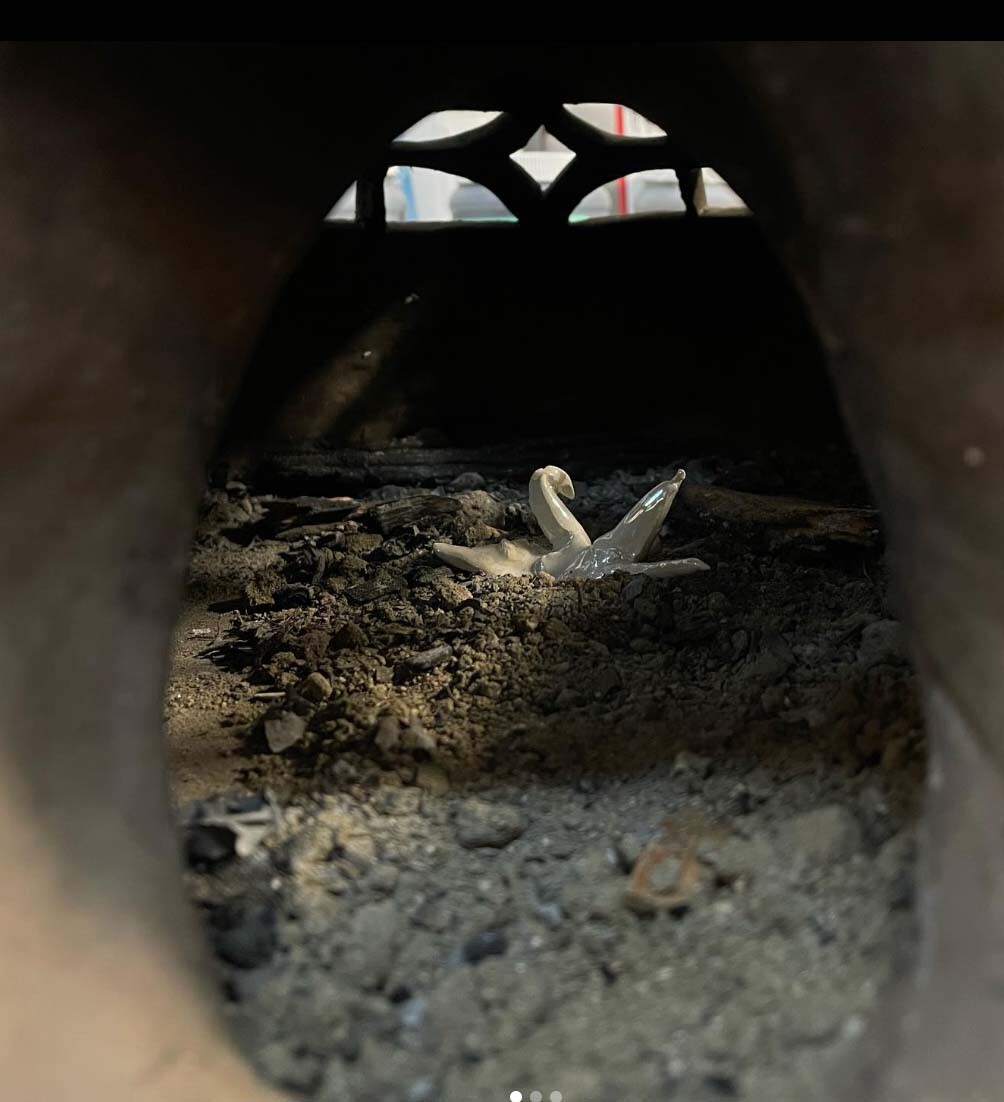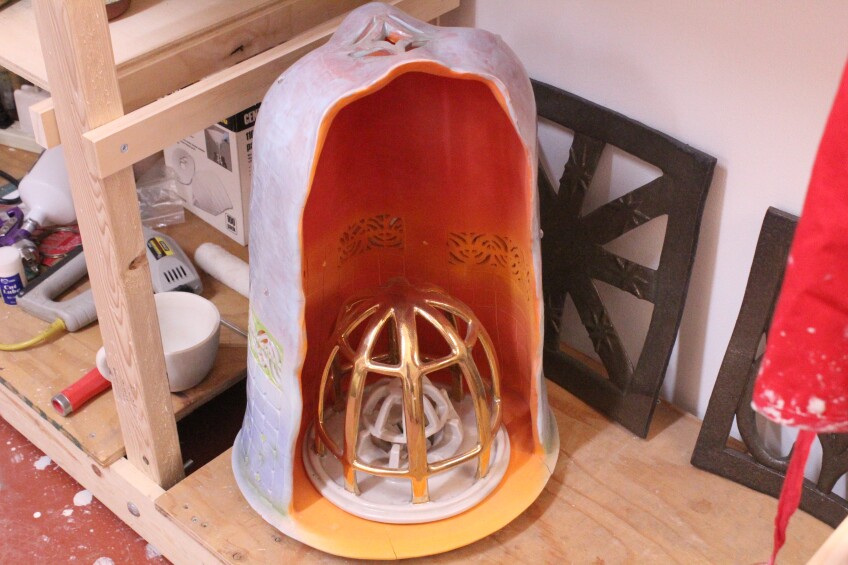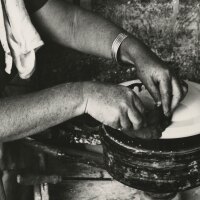Ceramic Artist Lizette Hernández Questions the Sacred

In many ways, ceramicist Lizette Hernández's work is radical. She connects with earthen materials and critiques religion, spirituality and tradition while addressing trauma and healing. The clay's materiality and the bricks' structure are symbolic as her hands manipulate the shape and intention behind her practice.
Hernández works out of Tlaloc Studios in South Central, where she creates ceramic sculptures tracing her familial roots and the symbiosis between nature and her body. Her work has been on display throughout the U.S., including local galleries like Blumenfield Projects, Matthew Brown Gallery and New Image Art, as well as East Coast galleries like Harkawik and Fortnight Institute. Her most recent collective show, "Rostro," was on view at Charles James Gallery in L.A.'s Chinatown.
As part of a group exhibition "Ahora" hosted by Tlaloc Studios and Thinkspace Projects, Hernández sculpted a stoneware altar, "Antes y Después de la Muerte" (2022). A creamy sand-colored piece hung at the Muzeo Museum and Cultural Center in Anaheim. Seven spikes jolt from the center — the number seven embraces a philosophy practiced by various Indigenous cultures, including Haudenosaunee (Iroquois) that believe every seven generations transformation and growth takes place. She decided to take agency over the meaning and channel it within an ashen thorn that stands out among the other spikes, a representation of how she imagines herself.

"I'm not leading my life the way my family necessarily raised me," says Hernández, "but I'm using my practice to honor the generations [before me] and the power that I have, that we all do."
Hernández, 29, grew up in Compton, surrounded by creativity but didn't have access to art disciplines. "Even before I was aware of the possibility of being an artist in contemporary time, I didn't know that it existed. With education, I didn't think what I was learning was for me to hold in my mind," she recounts.
An encouraging professor at Cypress Community College helped Hernández find her voice in ceramics. She began building set designs and props and working for a ceramic designer, then transferred to the University of California, Los Angeles (UCLA), graduating with an art degree in 2019. Hernández dove into ceramics, sculpture, painting, photography, video and even performance at school. It was a time to immerse herself in learning and working experimentally.

Hernández considers herself a family archivist, excavating and unearthing past stories. While drawing on themes of survival, class and gender splits — all channeled into her methodology and designs — she investigates histories buried with much pain often tied to religion and migration.
If it weren't for Hernández interrogating family truths, she wouldn't have identified patterns and learned that her father, when just a teenager, manufactured bricks as his first self-made job. He made the bricks, firing all at once and a kiln using cow manure purchased from her maternal grandfather. He later sold some of the bricks to his older brother — together, they built a family home. The house still stands, exposed brick on the ceiling cemented with mortar and white lines painted by her dad. Though Hernández's father no longer works with bricks, he helped lay the foundation for Hernández's contemporary work.

When Hernández incorporates bricks into her artistic process, it is figurative. She collapses the bricks and flattens them, compressing, in a way, inherited memories and experiences that have been suppressed. Working with bricks allows an understanding of her paternal side. Bricks can be associated with the home and matriarchal roles. "It also ties to the church. Knowing that women had so much power in the home, they were the first to be converted. That's how they [the Church] controlled the house," she says.
Hernández uses these bricks in a fire or reassembles them for a presentation. The piece entitled "Encender" (2021), shown at Various Small Fires gallery, consists of hollow bricks laid on each other, forming a base. A charcoal-colored adobe-shaped oven sits on top, marked with triangular designs serving as vents. Hernández initially lit wood inside the dome, arranging bricks into a pit fire and held a ceremony with another studio mate. Inside, the remains of ashes were culled together with leftover shards of trim forming a swan-like figure that reminded her of a duende — a spirit of the earth that comes out of creative rituals. "Encender" is layered with sentiment: a mother's pregnant belly holding a child and a horno (oven) bringing nourishment. It also touches on how people relate to their existence, potential, beliefs and prayer. "In my family, they cooked outdoors. That was their kitchen; that's how they survived," she says. "I think about how we shelter and protect ourselves."




Hernández's parents grew up in Los Altos de Jalisco, Mexico, the site of theCristero War — a religious uprising in the central-western part of the country in the early 20th century. The rebellion, which ended in favor of the church, was sparked by the anticlericalism of the Mexican government that sought, unsuccessfully, to eliminate the Catholic community's social, political and educational control. She shares that the town still carries their victory with pride, adding, "It's that instillment of fear with knowledge the church has always carried to keep control. I feel like that is deep in me, even in my blood."
Iconography plays a heavy role in Hernández's work: the symbolism of Virgen de Guadalupe as the matriarch and the sun, a primary life force. There is an astute devotion to the Catholic figure within the faith and Hernández mirrors this representation in "Sun Sculpture" (2022). The depiction of bright rays surrounding the blue mantle in imageries of Guadalupe is visible in her work — a neon light shines through the clay body as bold streaks dart in waves.


In a square series that resembles encased shrines, she reveals tethered and twisted roots with embellished surfaces, a charred terrain or an immersion beneath the soil. As such, "Regeneración" (2021) refers to rejuvenation with sculpted flowers that can be converted into miniature vessels for holy water — a commentary on humanity's disconnection from water as a sacred element offering sustenance. Others, including, "Nacimiento de una Luna" (2022) and "Adquirir" (2022) also critique how "Christianity has co-opted nature," she says.
A dusk-colored jug sits on top of stacked cinder blocks. The untitled work credits the traditional clay ware in Tlaquepaque, Jalisco's ceramic region. Our Lady of San Juan de los Lagos, a popular image venerated in the pueblo's namesake, was an inspiration for a container series. What stood out to Hernández was a pierced moon at the bottom of the figure's feet. Blood dripping down represents the homogenization of religion and reinforced torture. Hernández notes that an Indigenous person made the actual design, illustrating violent acts of colonization and oppression. With these vases, Hernández repurposes select images. Instead of a crown, the upside-down moon sits erect and two stars on either side replace angels — and on the backside, a candle imprinted with soot.






It went through several iterations. Hernández slapped the clay in a rhythmic trance as she thought about the subjectivity of figurative wounds. It was cathartic, she says. When the piece was fired and glazed, it split in the middle, mapping a scar on her face. She replaced it with different clay bodies, pinching the material, thinking about the infliction it causes on human skin. This time, it exploded. She attempted again, working with care instead of frustration and anger and it came out of the kiln perfectly intact and whole — not even a hairline crack.
As Hernández strums with ideas of protection and entrapment, she continues to open her studio space to the community and participate in a critique group.
"I'm not sad that I have to do this work — it fuels me. I will continue trying to understand who I am, where I come from and how we exist in the world, not my specific culture, but humanity," Hernández says. "So many people have similar experiences, and it's nuanced, but we're all, in some ways confused, trying to decipher what it is we want to continue and what cycles we want to end."




